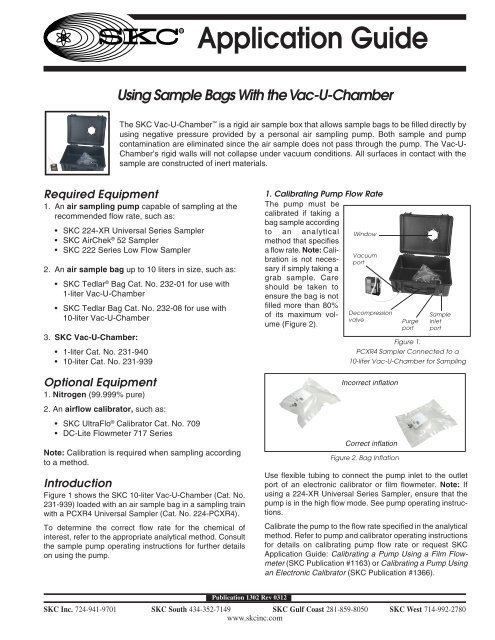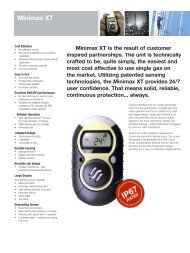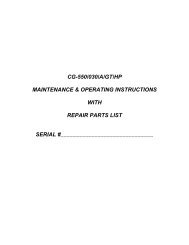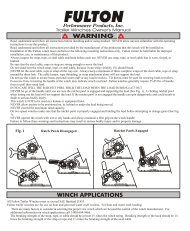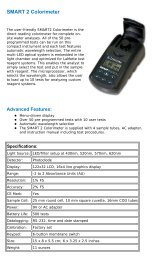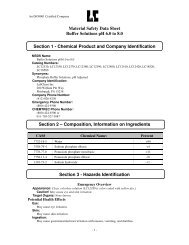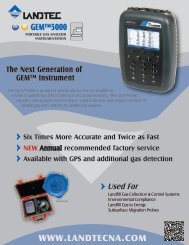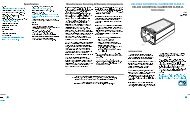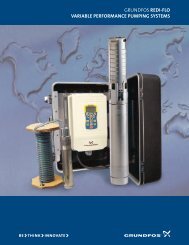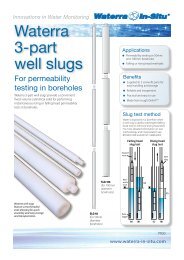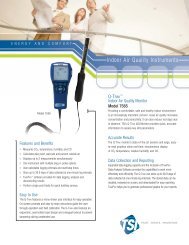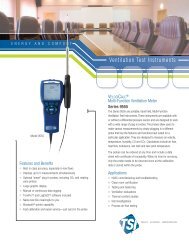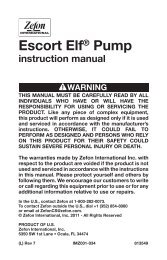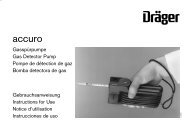Using Sample Bags with the Vac-U-Chamber - Field Environmental ...
Using Sample Bags with the Vac-U-Chamber - Field Environmental ...
Using Sample Bags with the Vac-U-Chamber - Field Environmental ...
- No tags were found...
Create successful ePaper yourself
Turn your PDF publications into a flip-book with our unique Google optimized e-Paper software.
Application Guide<strong>Using</strong> <strong>Sample</strong> <strong>Bags</strong> With <strong>the</strong> <strong>Vac</strong>-U-<strong>Chamber</strong>The SKC <strong>Vac</strong>-U-<strong>Chamber</strong> is a rigid air sample box that allows sample bags to be filled directly byusing negative pressure provided by a personal air sampling pump. Both sample and pumpcontamination are eliminated since <strong>the</strong> air sample does not pass through <strong>the</strong> pump. The <strong>Vac</strong>-U-<strong>Chamber</strong>’s rigid walls will not collapse under vacuum conditions. All surfaces in contact <strong>with</strong> <strong>the</strong>sample are constructed of inert materials.Required Equipment1. An air sampling pump capable of sampling at <strong>the</strong>recommended flow rate, such as:• SKC 224-XR Universal Series <strong>Sample</strong>r• SKC AirChek ® 52 <strong>Sample</strong>r• SKC 222 Series Low Flow <strong>Sample</strong>r2. An air sample bag up to 10 liters in size, such as:• SKC Tedlar ® Bag Cat. No. 232-01 for use <strong>with</strong>1-liter <strong>Vac</strong>-U-<strong>Chamber</strong>• SKC Tedlar Bag Cat. No. 232-08 for use <strong>with</strong>10-liter <strong>Vac</strong>-U-<strong>Chamber</strong>3. SKC <strong>Vac</strong>-U-<strong>Chamber</strong>:• 1-liter Cat. No. 231-940• 10-liter Cat. No. 231-939Optional Equipment1. Nitrogen (99.999% pure)2. An airflow calibrator, such as:• SKC UltraFlo ® Calibrator Cat. No. 709• DC-Lite Flowmeter 717 SeriesNote: Calibration is required when sampling accordingto a method.IntroductionFigure 1 shows <strong>the</strong> SKC 10-liter <strong>Vac</strong>-U-<strong>Chamber</strong> (Cat. No.231-939) loaded <strong>with</strong> an air sample bag in a sampling train<strong>with</strong> a PCXR4 Universal <strong>Sample</strong>r (Cat. No. 224-PCXR4).To determine <strong>the</strong> correct flow rate for <strong>the</strong> chemical ofinterest, refer to <strong>the</strong> appropriate analytical method. Consult<strong>the</strong> sample pump operating instructions for fur<strong>the</strong>r detailson using <strong>the</strong> pump.1. Calibrating Pump Flow RateThe pump must becalibrated if taking abag sample accordingto an analyticalmethod that specifiesa flow rate. Note: Calibrationis not necessaryif simply taking agrab sample. Careshould be taken toensure <strong>the</strong> bag is notfilled more than 80%of its maximum volume(Figure 2).Window<strong>Vac</strong>uumportDecompressionvalveIncorrect inflationCorrect inflationFigure 2. Bag InflationPurgeport<strong>Sample</strong>inletportFigure 1.PCXR4 <strong>Sample</strong>r Connected to a10-liter <strong>Vac</strong>-U-<strong>Chamber</strong> for SamplingUse flexible tubing to connect <strong>the</strong> pump inlet to <strong>the</strong> outletport of an electronic calibrator or film flowmeter. Note: Ifusing a 224-XR Universal Series <strong>Sample</strong>r, ensure that <strong>the</strong>pump is in <strong>the</strong> high flow mode. See pump operating instructions.Calibrate <strong>the</strong> pump to <strong>the</strong> flow rate specified in <strong>the</strong> analyticalmethod. Refer to pump and calibrator operating instructionsfor details on calibrating pump flow rate or request SKCApplication Guide: Calibrating a Pump <strong>Using</strong> a Film Flowmeter(SKC Publication #1163) or Calibrating a Pump <strong>Using</strong>an Electronic Calibrator (SKC Publication #1366).Publication 1302 Rev 0312SKC Inc. 724-941-9701 SKC South 434-352-7149 SKC Gulf Coast 281-859-8050 SKC West 714-992-2780www.skcinc.com
<strong>Using</strong> <strong>Sample</strong> <strong>Bags</strong> With <strong>the</strong> <strong>Vac</strong>-U-<strong>Chamber</strong>2. Assembling <strong>the</strong> Sampling TrainConnect <strong>the</strong> inlet stem of an appropriate size bag to <strong>the</strong>sample inlet (Teflon ® tubing) inside <strong>the</strong> <strong>Vac</strong>-U-<strong>Chamber</strong>(Figure 3) or use <strong>the</strong> Teflon tube adapter for bags <strong>with</strong> avertical valve (231 Series bags). Open <strong>the</strong> valve on <strong>the</strong> bag.Refer to <strong>the</strong> bag operating instructions. Attach <strong>the</strong> quickdisconnect fitting on <strong>the</strong> end of <strong>the</strong> supplied Tygon ® tubingto <strong>the</strong> purge port of <strong>the</strong> chamber and <strong>the</strong> open end of <strong>the</strong>tubing to <strong>the</strong> pump inlet (Figure 5). Before evacuating <strong>the</strong>sample bag, ensure that <strong>the</strong> red cap plug remains on <strong>the</strong>sample inlet port outside <strong>the</strong> chamber. Activate <strong>the</strong> pumpand allow it to run until <strong>the</strong> bag is completely evacuated.Turn off <strong>the</strong> pump. To purge <strong>the</strong> sample line, remove <strong>the</strong> redcap plug and connect a long Teflon sample line to <strong>the</strong>sample inlet port on <strong>the</strong> outside of <strong>the</strong> pump. Connect <strong>the</strong>loose end to a clean air source. Turn on <strong>the</strong> pump for aperiod adequate to purge <strong>the</strong> line. Repeat as needed.Timed SamplingActivate <strong>the</strong> pump calibrated to <strong>the</strong> recommended flow rateand record <strong>the</strong> start time. <strong>Sample</strong> for <strong>the</strong> time specified in<strong>the</strong> analytical method. Turn off <strong>the</strong> pump, record <strong>the</strong> stoptime, and close <strong>the</strong> valve on <strong>the</strong> bag.<strong>Sample</strong>s can be analyzed directly from <strong>the</strong> bag using acolor detector tube, or <strong>the</strong> sample can be sent to a laboratoryfor analysis.Figure 5.PCXR8 <strong>Sample</strong>rConnected to a1-liter <strong>Vac</strong>-U-<strong>Chamber</strong> forPurgingPurge Port<strong>Sample</strong>Inlet<strong>Vac</strong>uumPortFigure 3.Ports Inside a<strong>Vac</strong>-U-<strong>Chamber</strong>(1-liter ModelShown)Red Cap Plug(for bag evacuation)Pump Inlet<strong>Sample</strong> Inlet Port(connect purified air source here)Purge Port (Purge port located on front of 10-liter models)<strong>Vac</strong>uumPortDecompressionValve<strong>Sample</strong> InletPortFigure 4.Ports Outside a<strong>Vac</strong>-U-<strong>Chamber</strong>(1-liter ModelShown)Purge Port3. Filling <strong>the</strong> Bag <strong>with</strong> a <strong>Sample</strong>With <strong>the</strong> pump still attached to <strong>the</strong> Tygon tubing, detach <strong>the</strong>quick disconnect fitting from <strong>the</strong> purge port on <strong>the</strong> chamberand insert it into <strong>the</strong> vacuum port (Figures 1 and 4). Close<strong>the</strong> <strong>Vac</strong>-U-<strong>Chamber</strong> and secure both latches. Ensure that<strong>the</strong> decompression valve located below <strong>the</strong> handle is closed(Figure 4).Grab SamplingActivate <strong>the</strong> sampling pump and view <strong>the</strong> bag inflatingthrough <strong>the</strong> window on top (Figure 1). Allow <strong>the</strong> pump to rununtil <strong>the</strong> bag is approximately 80% full. Do not over inflate<strong>the</strong> bag (Figure 2). Turn off <strong>the</strong> pump and immediatelyopen <strong>the</strong> chamber. Close <strong>the</strong> valve on <strong>the</strong> bag. If <strong>the</strong>chamber is difficult to open after sampling, loosen <strong>the</strong> decompressionvalve to relieve <strong>the</strong> pressure produced duringsampling.Notice: This publication is intended for general information only and should not be used as a substitute for reviewing applicable government regulations, equipment operating instructions, or legal standards. Theinformation contained in this document should not be construed as legal advice or opinion nor as a final authority on legal or regulatory procedures.Publication 1302 Rev 03124. Shipping Bag <strong>Sample</strong>s<strong>Sample</strong> bags sent to a laboratory for analysis should bepacked loosely and padded to minimize possible puncturingduring shipment. Bag samples should not be shipped by airunless <strong>the</strong> cargo cabin is pressurized. A significant decreasein barometric pressure may cause sample bags toburst.Cleaning a BagFlush <strong>the</strong> bag to remove any possible contaminants. To doso, attach <strong>the</strong> sample bag to <strong>the</strong> sample inlet (Teflon tubing)inside <strong>the</strong> <strong>Vac</strong>-U-<strong>Chamber</strong> (Figure 3). Open <strong>the</strong> bag valve.Refer to <strong>the</strong> bag operating instructions. Connect a source ofpurified air, such as 99.9% nitrogen, <strong>with</strong> an appropriateregulator to <strong>the</strong> sample inlet port outside <strong>the</strong> <strong>Vac</strong>-U-<strong>Chamber</strong>(Figure 5).If desired, a charcoal tube (Cat. No. 226-09) can be insertedbetween <strong>the</strong> nitrogen source and <strong>the</strong> bag to fur<strong>the</strong>r reduce<strong>the</strong> chance of contamination. Open <strong>the</strong> valve on <strong>the</strong> regulatorand allow nitrogen to flow into <strong>the</strong> bag at approximately500 ml/min until <strong>the</strong> bag is filled to approximately 80%.Close <strong>the</strong> valve on <strong>the</strong> regulator fitting. Connect <strong>the</strong> openend of <strong>the</strong> supplied Tygon tubing to <strong>the</strong> pump inlet and <strong>the</strong>end <strong>with</strong> <strong>the</strong> quick disconnect fitting to <strong>the</strong> purge port on <strong>the</strong><strong>Vac</strong>-U-<strong>Chamber</strong> (Figure 5). Activate <strong>the</strong> pump to evacuate<strong>the</strong> bag. Caution: Direct vented air to a safe location. Donot inhale <strong>the</strong> exhaust air from <strong>the</strong> bag. Turn off <strong>the</strong> pump.Open <strong>the</strong> regulator valve and fill <strong>the</strong> bag again <strong>with</strong> nitrogen.Close <strong>the</strong> valve. Turn on <strong>the</strong> pump and evacuate <strong>the</strong> bagagain. Repeat <strong>the</strong> process as needed.Copyright 2001 - 2003SKC Inc. 724-941-9701 SKC South 434-352-7149 SKC Gulf Coast 281-859-8050 SKC West 714-992-2780www.skcinc.com


